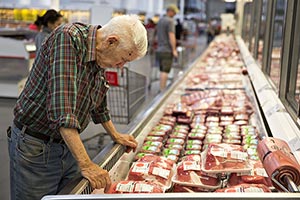New Year, Same Story for US Growth Driven by Consumers

Busy storefronts and an inflation pickup show the world’s largest economy is starting 2017 much the same way it ended 2016: driven by the consumer.
Retail sales rose more than forecast in January in a broad-based advance, and consumer prices climbed by the most in almost four years, government figures showed Feb. 15. Compared with a year earlier, purchases climbed by the most since March 2012. Even factory output increased for the fourth time in five months, the Federal Reserve reported.
The data, backed by a jump in consumer and business sentiment since Donald Trump’s election victory, indicate growth this quarter will get a boost from household spending, which accounts for about 70% of the economy. Rising demand and a recovery in commodity prices also are pushing inflation higher. Traders moved closer to placing a 50% probability on a March increase in borrowing costs by the Fed after the latest consumer-price data.
“The economy is still chugging along,” said Scott Brown, chief economist for St. Petersburg, Florida-based Raymond James Financial Inc. “Consumer spending is still pretty healthy. Inflation is getting closer to the Fed’s goal. This is a green light for the Fed to raise rates in coming months.”
The data fueled investor speculation that the Fed could raise interest rates sooner than previously anticipated, pushing Treasuries down and causing the dollar to temporarily rise Feb. 15. The 10-year Treasury yield topped 2.50%.
One caveat: Inflation is eating into consumers’ wallets and could curb spending appetites. A separate report from the Labor Department showed hourly earnings adjusted for inflation fell 0.5% in January from the prior month, the biggest drop since August 2012, and were unchanged over the past 12 months.
“We’re probably looking at less firepower in consumer spending going forward,” Brown said.
Americans nevertheless found the money for purchases last month. Retail sales rose 0.4%, exceeding the median estimate of economists for a 0.1% rise, Commerce Department data showed. Excluding a slowdown at car dealers, the gain at retailers was even more impressive — up 0.8%, the most in four months.
Purchases of electronics and appliances climbed the most since June 2015, sporting goods sales had the biggest advance since July 2015 and apparel stores showed the largest jump in receipts since February of last year.
Car purchases were the only major weak spot, consistent with industry results released earlier this month. Automobile dealers’ sales fell 1.4% in January after a 3.2% surge the previous month, the Commerce Department reported.
The inflation data suggest price gains are getting closer to the Fed’s goal. The consumer-price index rose a larger-than-forecast 0.6% from the previous month, the most since February 2013, after a 0.3% gain in December, Labor Department figures showed. A 7.8% jump in the cost of gasoline accounted for about half of the January increase.
Compared with the same month last year, costs paid by Americans for goods and services rose 2.5%, the most since March 2012.
The Fed targets 2% annual gains in a separate gauge, the personal consumption expenditures price index, which rose 1.6% in December from a year earlier.
Besides higher gasoline costs, clothing prices jumped by the most since February 2009, with men’s apparel surging by the most on record. New-vehicle prices had the biggest advance since November 2009.
The core CPI measure, which excludes volatile food and fuel costs, rose 0.3%, more than projected and the most in five months. Core prices were up 2.3% from January 2016.
A March interest-rate increase by the Federal Open Market Committee, an unlikely scenario just days ago, may be increasingly on the table.
“At our upcoming meetings, the committee will evaluate whether employment and inflation are continuing to evolve in line with these expectations, in which case a further adjustment of the federal funds rate would likely be appropriate,” Yellen told the Senate Banking Committee on Feb. 14.
A gradual recovery in manufacturing also is underway. Production at factories, which make up about 80% of all industrial output, increased 0.2% for a second month in January, according to Fed data.
“It looks like the economy is continuing to rip in the first quarter,” said Ward McCarthy, chief financial economist for Jefferies in New York. “Consumers continue to spend and are buying virtually everything. Inflation is accelerating. This opens the door for the Fed to raise rates in March.”



